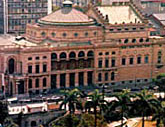|
Sao Paulo (Brazil)  Sao Paulo overwhelms the senses with its sheer size. With seventeen million inhabitants, it is the world's third largest city and the largest in South America. Sao Paulo and its rival Brazilian city, Rio de Janeiro(里约热内卢), have often been compared to New York and Los Angeles respectively. If Rio has gained fame for its striking natural setting, Sao Paulo's attraction lies in its people and its vibrant cultures. The Avenida Paulista's(圣保罗大街)canyon of upthrusting skyscrapers only hints at the city's sources of energy. A more cosmopolitan city than its counterpart, Sao Paulo possesses significant ethnic minority communities, including substantial Japanese, Italian, and Arab and Lebanese Christian neighbourhoods. Sao Paulo overwhelms the senses with its sheer size. With seventeen million inhabitants, it is the world's third largest city and the largest in South America. Sao Paulo and its rival Brazilian city, Rio de Janeiro(里约热内卢), have often been compared to New York and Los Angeles respectively. If Rio has gained fame for its striking natural setting, Sao Paulo's attraction lies in its people and its vibrant cultures. The Avenida Paulista's(圣保罗大街)canyon of upthrusting skyscrapers only hints at the city's sources of energy. A more cosmopolitan city than its counterpart, Sao Paulo possesses significant ethnic minority communities, including substantial Japanese, Italian, and Arab and Lebanese Christian neighbourhoods.
The array of nationalities living in Sao Paulo have made it a legendary city among gourmands(美食者): Japanese, Italian, Brazilian, Chinese, Jewish, and Arab restaurants are all familiar parts of the city's landscape. In fact, people often visit Sao Paulo just to dine out. The Jardins district is the center of the dining scene, and thus the center of the Sao Paulo social scene. Paulistanos eat late--restaurants often don't begin serving until 9pm or 10pm, and it is common for them to stay open until 3am.  Brazil's most modern, cosmopolitan city has much to offer in addition to its outstanding cuisines(烹饪). Its museums are among the finest in South America, its surrounding coastline is graced with many lovely beaches, and its entertainment and nightlife have for years attracted some of the best performers in the world. In recent years, the city has evolved into a center for Brazil's own martial art, capoeira(卡泼卫勒舞), whose dance-like motions are performed to music. The art has its own traditional instruments: drums and the berimbau(拨铃波琴), a stringed rod used to keep time. Originally developed as the martial art of the slaves of the Bahia, capoeira was banned by the ruling classes. To keep their art alive, the slaves turned capoeira into a dance, and the berimbau, which had warned of an approaching master, began to accompany the dance itself. As late as the 1920s capoeira was still outlawed and practiced only underground; today, it is a well-known and much-loved spectacle. Brazil's most modern, cosmopolitan city has much to offer in addition to its outstanding cuisines(烹饪). Its museums are among the finest in South America, its surrounding coastline is graced with many lovely beaches, and its entertainment and nightlife have for years attracted some of the best performers in the world. In recent years, the city has evolved into a center for Brazil's own martial art, capoeira(卡泼卫勒舞), whose dance-like motions are performed to music. The art has its own traditional instruments: drums and the berimbau(拨铃波琴), a stringed rod used to keep time. Originally developed as the martial art of the slaves of the Bahia, capoeira was banned by the ruling classes. To keep their art alive, the slaves turned capoeira into a dance, and the berimbau, which had warned of an approaching master, began to accompany the dance itself. As late as the 1920s capoeira was still outlawed and practiced only underground; today, it is a well-known and much-loved spectacle.
| 
 Sao Paulo overwhelms the senses with its sheer size. With seventeen million inhabitants, it is the world's third largest city and the largest in South America. Sao Paulo and its rival Brazilian city, Rio de Janeiro(里约热内卢), have often been compared to New York and Los Angeles respectively. If Rio has gained fame for its striking natural setting, Sao Paulo's attraction lies in its people and its vibrant cultures. The Avenida Paulista's(圣保罗大街)canyon of upthrusting skyscrapers only hints at the city's sources of energy. A more cosmopolitan city than its counterpart, Sao Paulo possesses significant ethnic minority communities, including substantial Japanese, Italian, and Arab and Lebanese Christian neighbourhoods.
Sao Paulo overwhelms the senses with its sheer size. With seventeen million inhabitants, it is the world's third largest city and the largest in South America. Sao Paulo and its rival Brazilian city, Rio de Janeiro(里约热内卢), have often been compared to New York and Los Angeles respectively. If Rio has gained fame for its striking natural setting, Sao Paulo's attraction lies in its people and its vibrant cultures. The Avenida Paulista's(圣保罗大街)canyon of upthrusting skyscrapers only hints at the city's sources of energy. A more cosmopolitan city than its counterpart, Sao Paulo possesses significant ethnic minority communities, including substantial Japanese, Italian, and Arab and Lebanese Christian neighbourhoods. Brazil's most modern, cosmopolitan city has much to offer in addition to its outstanding cuisines(烹饪). Its museums are among the finest in South America, its surrounding coastline is graced with many lovely beaches, and its entertainment and nightlife have for years attracted some of the best performers in the world. In recent years, the city has evolved into a center for Brazil's own martial art, capoeira(卡泼卫勒舞), whose dance-like motions are performed to music. The art has its own traditional instruments: drums and the berimbau(拨铃波琴), a stringed rod used to keep time. Originally developed as the martial art of the slaves of the Bahia, capoeira was banned by the ruling classes. To keep their art alive, the slaves turned capoeira into a dance, and the berimbau, which had warned of an approaching master, began to accompany the dance itself. As late as the 1920s capoeira was still outlawed and practiced only underground; today, it is a well-known and much-loved spectacle.
Brazil's most modern, cosmopolitan city has much to offer in addition to its outstanding cuisines(烹饪). Its museums are among the finest in South America, its surrounding coastline is graced with many lovely beaches, and its entertainment and nightlife have for years attracted some of the best performers in the world. In recent years, the city has evolved into a center for Brazil's own martial art, capoeira(卡泼卫勒舞), whose dance-like motions are performed to music. The art has its own traditional instruments: drums and the berimbau(拨铃波琴), a stringed rod used to keep time. Originally developed as the martial art of the slaves of the Bahia, capoeira was banned by the ruling classes. To keep their art alive, the slaves turned capoeira into a dance, and the berimbau, which had warned of an approaching master, began to accompany the dance itself. As late as the 1920s capoeira was still outlawed and practiced only underground; today, it is a well-known and much-loved spectacle.






